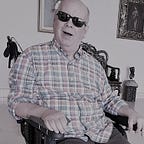How I Learnt to be a Non-Believer Catholic.
When my parents in Sama de Langreo, Asturias, wanting to get married, they went to the town’s priest, Don Gabino, but he first refused to marry them, saying that my father was O.K., but “she”, referring to my mother, “she is not of good quality”, he said.
The priest was blaming my mother for the Communist activities of her father Eugenio, killed by the Civil Guard in 1939 after Franco won the Spanish Civil War.
It was only when faced with the threat made by my father (R.I.P.), who said that they would start to live together, all the same if he refused to marry them, that the priest, Don Gabino, agreed to perform their marrying ceremony.
In other order of ideas:
At the school I attended at the age of 13 in Asturias, Confession all the first Thursdays of each month and Communion every first Friday, were mandatory (Freedom of religion? In Franco’s Spain such thing didn’t exist).
Our classroom there had a big crucifix hung in the wall, prominently, in front of us, and at its side a photograph of a young Franco in military uniform and a sign that read:
“Spain’s leader, by God’s grace”.
But please, allow me to continue with the story.
…In order to confess our sins, we went in line of one to a nearby church, distant only about 100 meters from the school.
There, an enraged priest dressed all in black, perched on the pulpit, put fear in our young minds, stigmatizing us as sinners, we, “who wouldn’t reach Redemption unless we confessed all of our sins”.
Naturally enough, the first Thursday of every month when we had Confession, the students that didn’t have any sins to confess, just made them up; anything and everything, so long as to confess, therefore being able to have Communion the following day, and thus reach Eternal Life.
It shouldn’t be a surprise to anyone, that with those personal experiences, plus my readings about the activities and preached dogma of lots of representatives of the Catholic Church (and sometimes of the Church itself), I find it hard to believe the Catholic rhetoric. It shouldn’t be surprising, I repeat, that I find extremely difficult, almost impossible, to believe anything Church’s ministers say.
From the sexual abuse of children for years, amid total silence of the Church, to the criminal condemnation of the use of condoms, in an Africa plagued by AIDS, not to mention its historical bias against women and sex, the Catholic Church seems to have lots of prejudices. which acted historically against humanity.
I visited once the Museum of Spanish Inquisition in Cartagena, Colombia, and I have to confess I was horrified by the sadistic characteristics and refinement of the diversity of torture instruments exhibited there.
How could a human being be capable of acting with such ferocity and cruelty against fellow humans? And worst… in the name of religious purity.
While it is true that the Spanish Inquisition was more of a sinister political maneuver of the Spanish rulers to escape Rome’s control, and — Catholic orthodoxy — was used by the Spanish sovereignty more as a cruel unifying method, to unite a territory split by race, and religious beliefs and practices, it’s also true that Rome ran its own inquisition — the Roman Inquisition —, which started during the second half of the 16th century, and lasted well into the mid-1800s, when pre-unification Italian states began to suppress the local inquisitions, effectively eliminating the power of the Church to prosecute heretical crimes, although the institution survived to the present days.
It changed names in 1908, and again in 1965, being renamed today as Supreme Sacred Congregation of the Holy Office, eliminating the word Inquisition from its official name in 1908.
The Roman Inquisition was officially responsible for prosecuting individuals accused of a wide array of crimes relating to religious doctrine, alternate religious doctrine, or alternate religious beliefs, and was totally under Papal control.
Paragraphs in bold lettering, taken from Wikipedia.com
Although less bloody and cruel than the Spanish Inquisition, the Roman Inquisition nevertheless, was guided by obscurantism and prejudice, as demonstrated by counting among its victims the well-known Galileo and Copernicus, among others.
Italian historian Andrea Del Col, cited by Wikipedia, estimates that out of 51,000–75,000 cases judged by [the Roman] Inquisition in Italy after 1542, around 1,250 resulted in a death sentence.
I think humanity has been excessively generous and forgiving — I’m not — with an institution which has caused — and still does — so much damage and suffering to human beings.
I atribute such generosity and seemingly capacity for easy forgiveness to both, a distinction by Catholics between their God and his (human) Church’s representatives, and to the human need to believe in some form of life after death, thus explaining our existence.
Even if we account for the many good activities of some of its members (In Education and Healthcare, for example), I think the Catholic Church is still in debt-heavy debt-with Humanity.
Besides, had I been born in China, for instance, more than probably I’d practice Buddhism or Taoism, wouldn’t I?
I hope I explained why I’m a non-believer Catholic.
